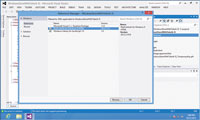Product Reviews
Product Review: Telerik RadControls for Windows 8
The first native Windows 8 controls suite for creating Windows Store apps fills key gaps in the Visual Studio XAML and HTML5/JavaScript toolbox.
Of the major tools vendors, Telerik Inc. was first out of the gate with a commercial suite of native Windows 8 controls in mid-October. (As I write this review, ComponentOne and Developer Express Inc. offer previews of their respective Windows 8 controls, and Infragistics is releasing the beta of its NetAdvantage for Windows UI package.)
The initial offering from Telerik is a small package of 20 controls. Included in the package are six graph/chart controls, four data-entry controls and -- the jewels in the crown -- the HubTile and Pagination controls for supporting the tile-based interface of Windows Store (formerly "Metro-style") projects. The controls are very good and fill key gaps in the Windows 8 toolbox. Do be aware, though: These are native Windows 8 controls, so they not only require Visual Studio 2012, they'll only install on a computer running Windows 8.
Telerik provides four dedicated HubTile controls for implementing the behavior of the tiles you see in the Windows 8 home screen. The RadHubTile allows you to display notification text; the RadSlideHubTile displays a graphic and a title (which can be more than just text); the RadMosaicHubTile is a container for a set of images; and the RadCustomHubTile lets you define two sets of content and swivel between them. The Pagination control allows you to walk the user through a set of pages, each displaying some combination of graphics and text (including thumbnail previews of the next page).
XAML and HTML5
You can use these Telerik controls to create Windows Store applications in both XAML and HTML5/JavaScript projects. Using the controls in an HTML5 project requires minimal setup in the project, as well as in each project page where you're using the controls. Once you've done that, however, you can open your project in Microsoft Blend to drag the controls from the Assets view (under the References entry) in the same way you drag the controls from the Toolbox in a XAML application. If you're Blend-averse, you'll need to enter the controls' tags into your HTML to use the controls in an HTML5/JavaScript project in Visual Studio, where you'll get IntelliSense support.
Telerik debuted the package in October for $99. At that price, RadControls for Windows 8 -- which includes a one-year subscription of updates and new controls -- was a steal. However, the company plans to start raising the price in $100 increments each month (beginning in December) as it introduces more controls, until RadControls for Windows 8 reaches the estimated full price of $999 in August 2013. Paying almost $1,000 for 20 or more controls seems like hubris to me -- and I like these controls. The goal is to encourage developers to commit to the Telerik package before others hit the market.

[Click on image for larger view.] |
| To use the HTML5/JavaScript versions of the controls, add a reference to the Telerik RadControls library and four link tags on each page where you're using the controls. |
If I were building a Windows Store application right now, I'd really like to have the HubTile controls (the Date/TimePickers are nice, but there are freeware tools that I could try). At the current price, I'd buy. Once the price gets closer to $999, though, I'd wait for some competition in the marketplace or for the suite to acquire a lot more controls.
Telerik Inc.
Web: telerik.com
Phone: 888-365-2779
Price: $99 (as of October 2012; rising to $999 by August 2013)
Quick Facts: A collection of 20 controls for building Windows Store apps
Pros: Excellent support for tile-based UIs in both XAML and HTML5/JavaScript projects
Cons: Not many controls right now for what will soon be an awful lot of money
About the Author
Peter Vogel is a system architect and principal in PH&V Information Services. PH&V provides full-stack consulting from UX design through object modeling to database design. Peter tweets about his VSM columns with the hashtag #vogelarticles. His blog posts on user experience design can be found at http://blog.learningtree.com/tag/ui/.